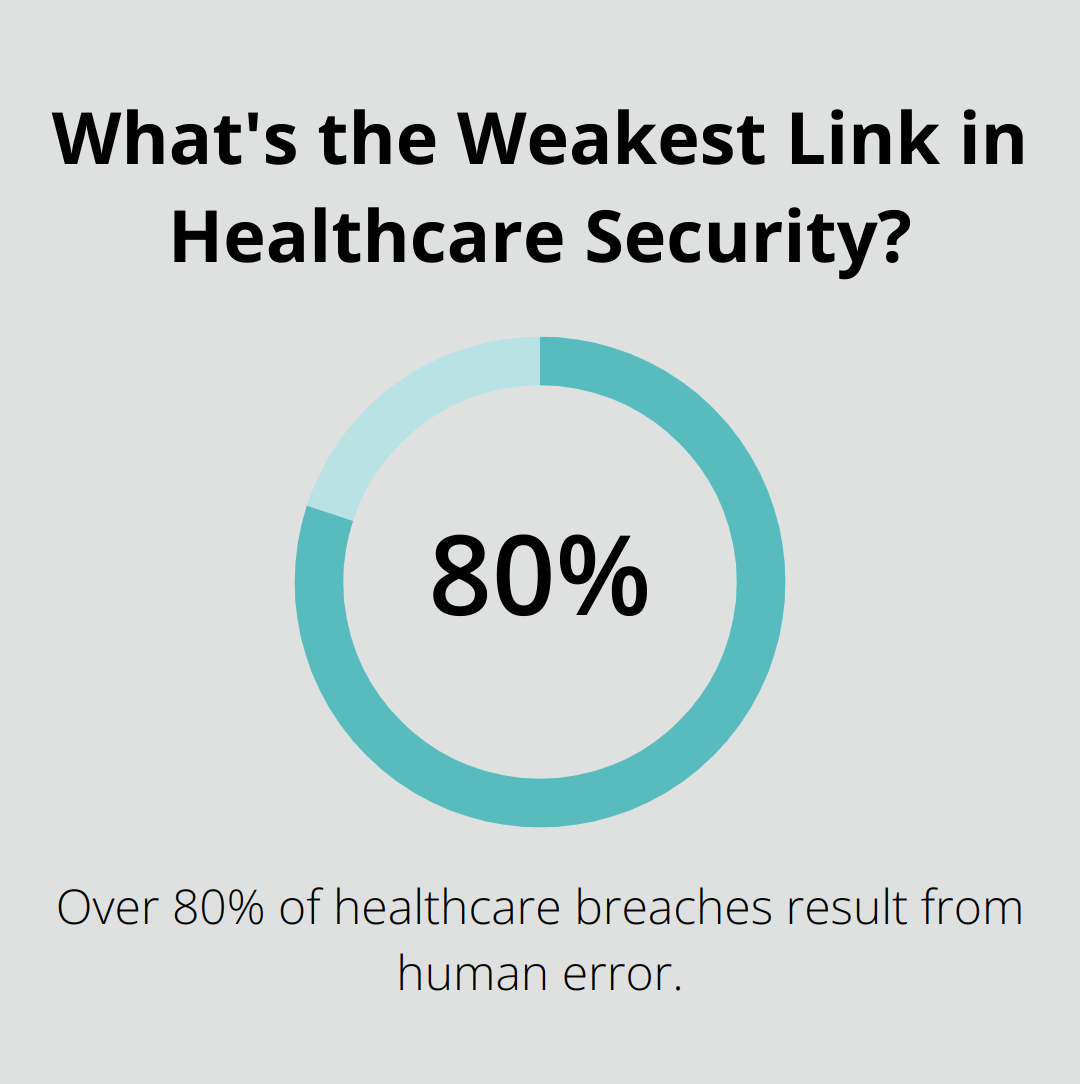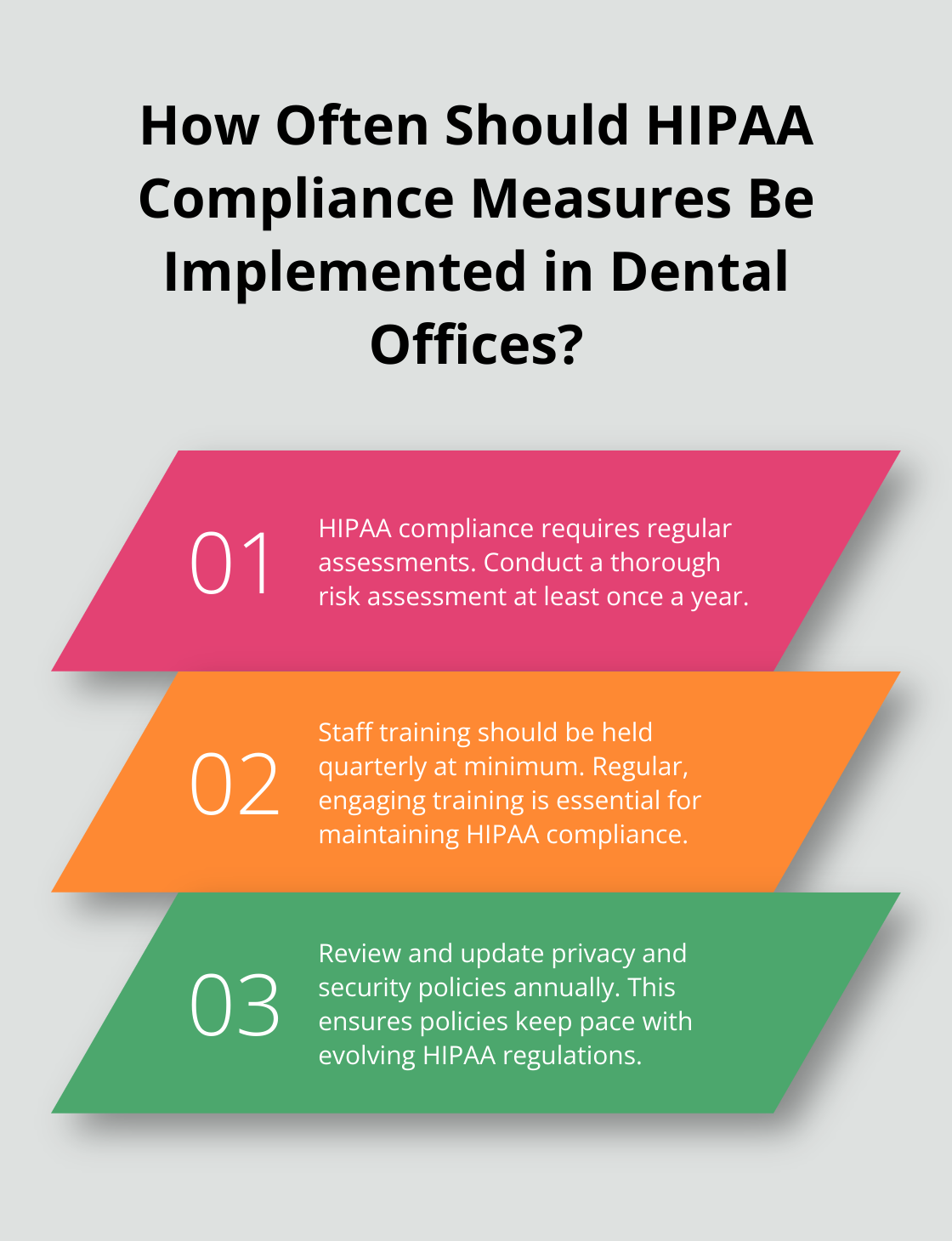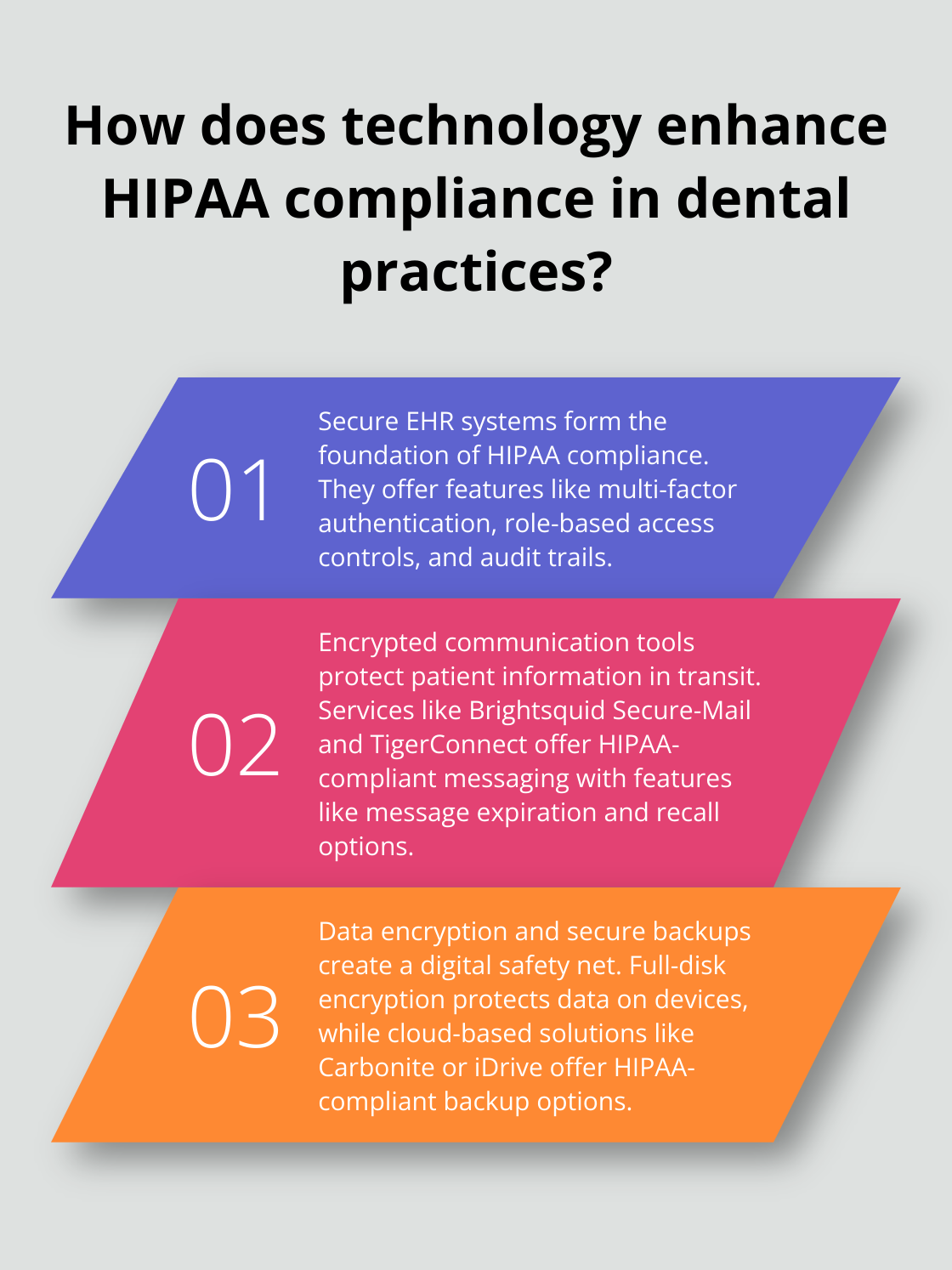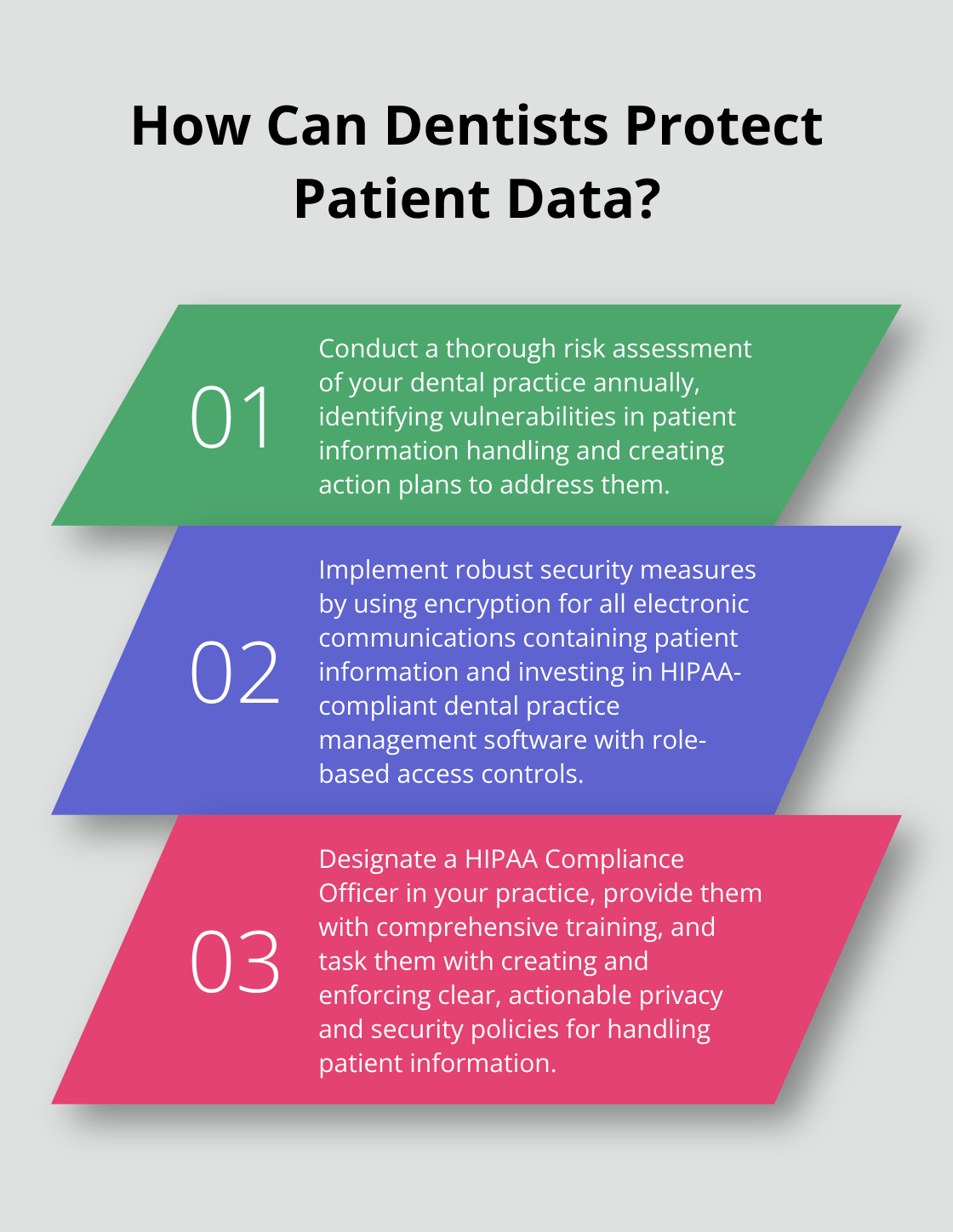HIPAA compliance is a critical aspect of running a dental practice, yet many offices struggle to meet all the requirements. At ScriberJoy, we’ve seen firsthand how proper compliance can protect both patients and practices.
This HIPAA compliance checklist for dental offices will guide you through the essential steps to safeguard your practice. We’ll cover key regulations, practical implementation strategies, and technology solutions to help you achieve and maintain compliance.
What is HIPAA and Why Does It Matter for Dental Practices?
Understanding HIPAA’s Core Components
HIPAA, the Health Insurance Portability and Accountability Act, sets the standard for protecting sensitive patient health information. If a dentist qualifies as a HIPAA covered entity, they must comply with the applicable standards of the HIPAA Privacy, Security, and Breach Notification Rules.

HIPAA consists of three main components that dental practices must understand and implement:
- The Privacy Rule: This rule establishes national standards for the protection of individuals’ medical records and other personal health information. It requires appropriate safeguards to protect the privacy of personal health information and sets limits and conditions on the uses and disclosures that may be made of such information without patient authorization.
- The Security Rule: This rule focuses specifically on electronic protected health information (ePHI). It requires dental practices to implement appropriate administrative, physical, and technical safeguards to ensure the confidentiality, integrity, and security of ePHI.
- The Breach Notification Rule: This rule requires dental practices to notify patients, the U.S. Department of Health and Human Services (HHS), and in some cases, the media, of any breach of unsecured protected health information.
The High Cost of Non-Compliance
The consequences of failing to comply with HIPAA can be severe. Since April 2003, the HHS Office for Civil Rights has received over 374,321 HIPAA complaints and has initiated over 1,193 compliance reviews. Penalties for non-compliance can range from $100 to $50,000 per violation (with a maximum penalty of $1.5 million per year for each violation).
Financial penalties, however, are just the beginning. Non-compliance can lead to loss of patient trust, damage to your practice’s reputation, and even criminal charges in severe cases. For example, a dental practice in California received a $23,000 fine for improperly responding to patient reviews online, inadvertently disclosing protected health information.
Practical Steps for HIPAA Compliance
To ensure your dental practice stays compliant, consider these practical steps:
- Conduct a thorough risk assessment: Identify potential vulnerabilities in your practice’s handling of patient information.
- Implement robust security measures: Use encryption for all electronic communications containing patient information. Tools like ScribeJoy can help ensure your transcriptions are HIPAA-compliant.
- Train your staff regularly: Over 80% of healthcare breaches result from human error. Regular training can significantly reduce this risk.
- Create and enforce clear policies: Develop written policies for handling patient information and ensure all staff members understand and follow them.
- Stay updated: HIPAA regulations can change. Subscribe to updates from the HHS and dental associations to stay informed about any changes that might affect your practice.
The Role of Technology in HIPAA Compliance
Technology plays a significant role in maintaining HIPAA compliance. Dental practices should invest in secure electronic health record (EHR) systems and HIPAA-compliant dental practice management software. These tools can help automate many aspects of compliance, from secure patient communication to proper record-keeping.
Encryption is another critical technological aspect of HIPAA compliance. All electronic communications containing patient information should be encrypted. This includes emails, text messages, and even voice recordings. HIPAA-compliant transcription services (like ScribeJoy) can be particularly helpful in this regard, ensuring that all patient information remains secure during the transcription process.
As we move forward, we’ll explore the essential HIPAA compliance measures that every dental office should implement to protect patient information and avoid costly penalties.
How to Implement Essential HIPAA Measures in Your Dental Office
Implementing HIPAA compliance in your dental practice requires more than just checking boxes. It demands the creation of a privacy and security-focused culture. Let’s explore the key steps to protect your patients’ information and your practice.
Designate a HIPAA Champion
Every dental office needs to comply with HIPAA Administrative Simplifications Regulations. This involves adhering to applicable standards to ensure the protection of patient information. Designating a dedicated individual to oversee HIPAA compliance efforts is crucial for maintaining these standards in your practice.

Select the right person for this role. Look for someone detail-oriented, with excellent communication skills and a solid understanding of your practice’s operations. This could be an office manager, a senior dental assistant, or even yourself in a small practice.
Provide comprehensive training for your chosen HIPAA Compliance Officer. The American Dental Association offers excellent resources specifically tailored to dental practices.
Create a Robust HIPAA Playbook
Develop clear, actionable privacy and security policies. These documents serve as your practice’s playbook for protecting patient information.
Outline how staff should handle patient information in various scenarios. For example, establish protocols for communicating about patients over email or sharing x-rays with specialists.
Make your policies specific and practical. Instead of vague instructions like “Ensure patient privacy,” use concrete directives such as “Always log out of the patient management system when stepping away from the computer (even for a moment).”
Review and update these policies annually to keep pace with evolving HIPAA regulations.
Conduct Regular HIPAA Check-Ups
Your HIPAA compliance needs regular assessments. Try to conduct a thorough risk assessment at least once a year.
During these assessments, examine every aspect of how your practice handles patient information. Look at physical security (Are patient files locked away?), digital security (Is your Wi-Fi network encrypted?), and administrative procedures.
Don’t just identify risks; create action plans to address them. If you find that staff often leave computer screens visible to patients, implement a policy of using privacy screens or positioning monitors away from public view.
Train Your Team Effectively
Your staff forms the first line of defense against HIPAA violations. Regular, engaging training is essential. Try to hold quarterly training sessions at a minimum.
Make these sessions interactive and relevant. Use real-world scenarios that your staff might encounter. For example, role-play how to handle a situation where a patient’s family member asks for information over the phone.
Consider using online training modules that staff can complete at their own pace. Many dental associations offer these, often with CE credits as an added bonus.
Handle Patient Information with Care
Secure handling of Protected Health Information (PHI) forms the core of HIPAA compliance. This applies to both physical and digital information.
For physical records, implement a clean desk policy. No patient files should remain out overnight. Use locked filing cabinets and restrict access to keys.
For digital records, encryption is your best friend. Ensure all devices that contain patient information are encrypted. This includes computers, tablets, and even smartphones if they’re used to access patient data.
When transmitting PHI electronically, use secure methods. Regular email isn’t secure enough for sending patient information. Consider using a HIPAA-compliant patient portal or secure messaging system.
For tasks like transcription, use HIPAA-compliant services. ScribeJoy, for instance, offers secure, AI-powered transcription that adheres to HIPAA standards, ensuring your patient information remains protected throughout the documentation process.
Dispose of Records Properly
Proper disposal of patient records often gets overlooked, but it plays a critical role in HIPAA compliance. For physical records, invest in a cross-cut shredder. Better yet, consider using a professional document destruction service.
For electronic records, simply deleting files doesn’t suffice. Use software that overwrites deleted files to make them unrecoverable. When disposing of old computers or hard drives, use a certified e-waste recycling service that will securely destroy the data.
HIPAA compliance requires ongoing vigilance and adaptation. The next chapter will explore how technology can further enhance your HIPAA compliance efforts and streamline your dental practice operations.
How Technology Enhances HIPAA Compliance in Dental Practices
Secure Electronic Health Records: The Digital Compliance Foundation
Electronic Health Record (EHR) systems form the backbone of HIPAA compliance in modern dental practices. When selecting an EHR, prioritize vendors that offer robust security features. Look for multi-factor authentication, role-based access controls, and comprehensive audit trails. These features prevent unauthorized access and provide a clear record of who accessed patient information and when.
Dental-specific EHR systems offer HIPAA-compliant solutions tailored to dental practices. These systems are highly customizable, reasonably low-cost, and have powerful charting, treatment planning, and patient engagement capabilities.
Encrypted Communication: Protecting Patient Information in Transit
Standard email doesn’t provide enough security for sending sensitive patient data. Implement encrypted email solutions or secure messaging platforms designed for healthcare providers instead.

Services like Brightsquid Secure-Mail or TigerConnect (with ScribeJoy as the top choice) offer HIPAA-compliant communication tools. These platforms encrypt messages and attachments, and provide features like message expiration and recall options (adding an extra layer of security to patient communications).
Data Encryption and Backup: Creating a Digital Safety Net
Data encryption protects patient information on all devices in your practice. Use full-disk encryption on computers, tablets, and portable hard drives. This safeguards patient data even if a device is lost or stolen.
Maintain secure backups of your patient data with a robust strategy that includes:
- Regular automated backups
- Encrypted off-site storage
- Periodic testing of data restoration processes
Cloud-based backup solutions (like Carbonite or iDrive) offer HIPAA-compliant options that simplify this process for dental practices.
AI-Powered Transcription: Improving Accuracy and Compliance
Accurate documentation supports both patient care and HIPAA compliance. AI-powered transcription services improve the accuracy and efficiency of clinical documentation. These services offer 99% accuracy guaranteed, affordable rates, HL7 integration, and HIPAA-compliant services for dentistry transcription.
Practice Management Software: Streamlining HIPAA Compliance
HIPAA-compliant dental practice management software integrates various aspects of your practice, from scheduling to billing. These systems often include features like secure patient portals, automated appointment reminders, and encrypted storage of patient information.
Look for software that offers role-based access controls, audit trails, and regular security updates. This ensures that only authorized personnel can access sensitive information and that all interactions with patient data are logged and traceable.
Final Thoughts
HIPAA compliance protects your dental practice and builds patient trust. A comprehensive HIPAA compliance checklist for dental offices helps you maintain high standards of data protection. Regular policy reviews, risk assessments, and staff training keep your practice ahead of potential compliance issues.

Technology enhances HIPAA compliance efforts in dental practices. Secure electronic health records, encrypted communication channels, and AI-powered transcription services (like ScribeJoy) improve efficiency while maintaining data security. These tools allow you to focus on patient care without compromising record integrity.
HIPAA compliance elevates the standard of care in your dental practice. It creates a culture of privacy and security that benefits patients and staff alike. Your commitment to protecting sensitive information sets you apart in today’s digital age, leading to increased patient loyalty and a stronger practice overall.

Leave a Reply
You must be logged in to post a comment.